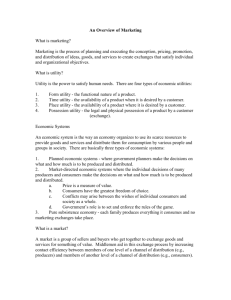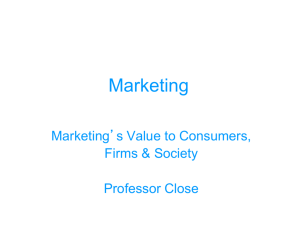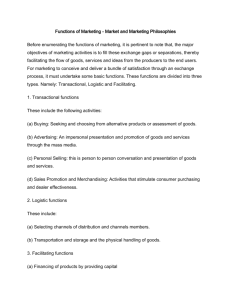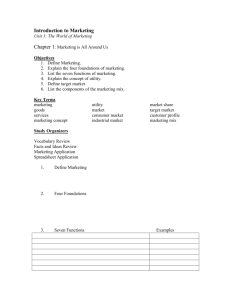HW#1: Ch 1 Questions
advertisement
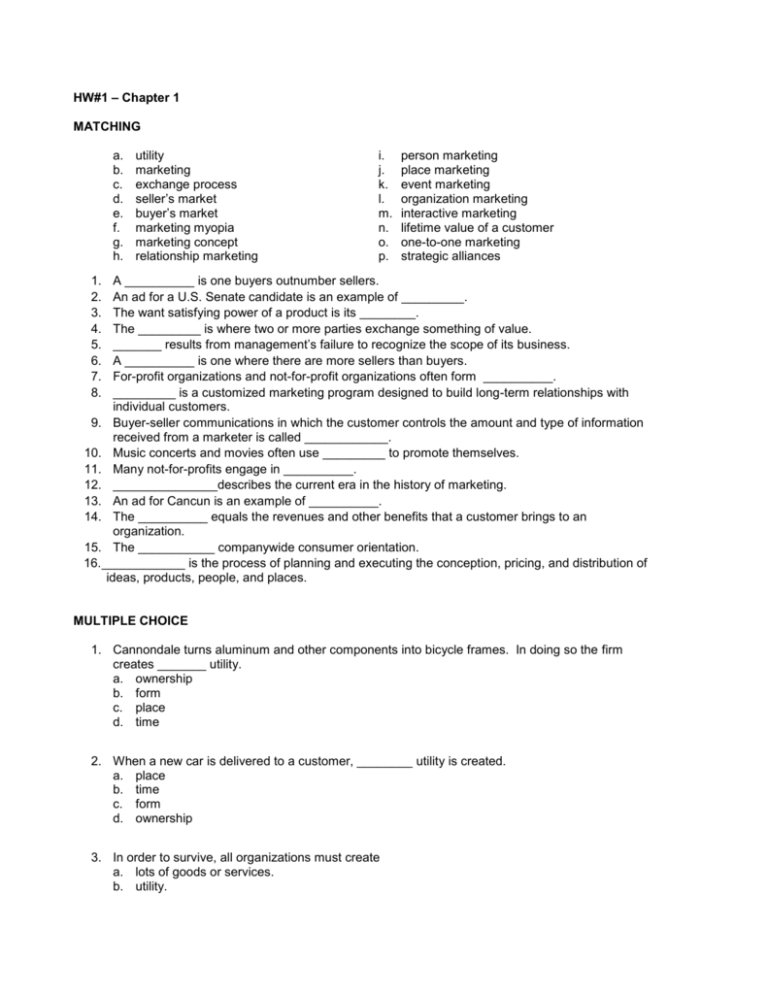
HW#1 – Chapter 1 MATCHING a. b. c. d. e. f. g. h. utility marketing exchange process seller’s market buyer’s market marketing myopia marketing concept relationship marketing i. j. k. l. m. n. o. p. person marketing place marketing event marketing organization marketing interactive marketing lifetime value of a customer one-to-one marketing strategic alliances 1. 2. 3. 4. 5. 6. 7. 8. A __________ is one buyers outnumber sellers. An ad for a U.S. Senate candidate is an example of _________. The want satisfying power of a product is its ________. The _________ is where two or more parties exchange something of value. _______ results from management’s failure to recognize the scope of its business. A __________ is one where there are more sellers than buyers. For-profit organizations and not-for-profit organizations often form __________. _________ is a customized marketing program designed to build long-term relationships with individual customers. 9. Buyer-seller communications in which the customer controls the amount and type of information received from a marketer is called ____________. 10. Music concerts and movies often use _________ to promote themselves. 11. Many not-for-profits engage in __________. 12. _______________describes the current era in the history of marketing. 13. An ad for Cancun is an example of __________. 14. The __________ equals the revenues and other benefits that a customer brings to an organization. 15. The ___________ companywide consumer orientation. 16. ____________ is the process of planning and executing the conception, pricing, and distribution of ideas, products, people, and places. MULTIPLE CHOICE 1. Cannondale turns aluminum and other components into bicycle frames. In doing so the firm creates _______ utility. a. ownership b. form c. place d. time 2. When a new car is delivered to a customer, ________ utility is created. a. place b. time c. form d. ownership 3. In order to survive, all organizations must create a. lots of goods or services. b. utility. c. products. d. advertising, salesmanship, and all other forms of sales promotion. 4. FedEx offers a variety of package delivery services. In doing so the firm creates a. time utility. b. place utility. c. ownership utility. d. form utility. 5. When a firm converts raw materials and other inputs into finished products a. ownership utility is created. b. form utility is created. c. time utility is created. d. place utility is created. 6. The want-satisfying power of a product is its a. utility. b. price. c. buyer’s attraction. d. function. 7. Which of the following statements is correct? a. Marketing is the term used to refer only to the sales function within a firm. b. Marketing managers usually don’t get involved in production or distribution decisions. c. Marketing is an activity that considers only the needs of the organization, not the needs of society as a whole. d. Marketing is the process of planning and executing the conception, pricing, promotion, and distribution of ideas, goods, services, organizations, events to create and maintain relationships that will satisfy individual and organizational objectives. 8. The United States is an attractive market for foreign firms for all of the following reasons except a. the U.S. is a large market. b. U.S. consumers enjoy a relatively high standard of living. c. the U.S. economy is growing much faster than the rest of the world. d. U.S. consumers are willing to purchase foreign products. 9. Assume a U.S. firm is considering marketing its products in another country. The new market is very attractive but that country’s cultural and legal environments are different compared to the U.S.. Based only on the information provided, how should the firm proceed. a. Avoid the new market completely and focus only on the domestic market. b. Enter the new market using the same marketing strategy the firm uses in the U.S. c. Enter the new market using the same marketing strategy it employs in existing foreign markets. d. Enter the new market using a new marketing strategy designed for that specific market. 10. Which of the following U.S. companies actually has a foreign parent? a. UPS b. Pillsbury c. ExxonMobil d. McDonald’s 11. Approximately what percentage of new products fail? a. Less than 25 percent. b. Between 25 percent and 50 percent. c. Between 50 percent and 75 percent. d. More than 75 percent. 12. In the history of marketing, when did the production era end in the United States? a. In the late 1800s. b. In the early 1900s. c. In the 1920s. d. After the end of the Second World War. 13. A marketing philosophy summarized by the phrase “a good product will sell itself” is characteristic of the _________ era. a. production b. sales c. marketing d. relationship 14. A company produces a high quality product. Its maximum monthly production is 10,000 units. The company produces that amount each month and then relies on its marketing department to find customers. This approach is consistent with which era in marketing history? a. The production era. b. The relationship era. c. The marketing era. d. The sales era. 15. Which of the following factors contributed to the transition from the production era to the sales era? a. Increased consumer demand. b. More sophisticated production techniques. c. Increase in urbanization. d. The Great Depression. 16. A company with a ______ orientation assumes that customers will resist purchasing products not deemed essential. The job of marketers is to overcome this resistance through personal selling and advertising. a. production b. marketing c. relationship d. sales 17. The emergence of the marketing concept can best be explained by a. higher production levels. b. a shift from a production to a sales orientation. c. a shift from a seller’s market to a buyer’s market. d. a focus on product quality. 18. In the relationship era firms focus on __________ relationships with __________. a. short term; customers and suppliers b. long term; customers and suppliers c. short term; customers d. long term; customers 19. When did relationship marketing emerge? a. Right after the end of the Second World War. b. During the mid 1960s. c. During the mid 1980s. d. During the 1990s. 20. A buyer’s market is characterized by a. fewer buyers than available goods and services. b. more buyers than available goods and services. c. practically no competition in the marketplace. d. slow economic growth.
